Chapter 7-Non-finite verb 3
什么是非谓语动词
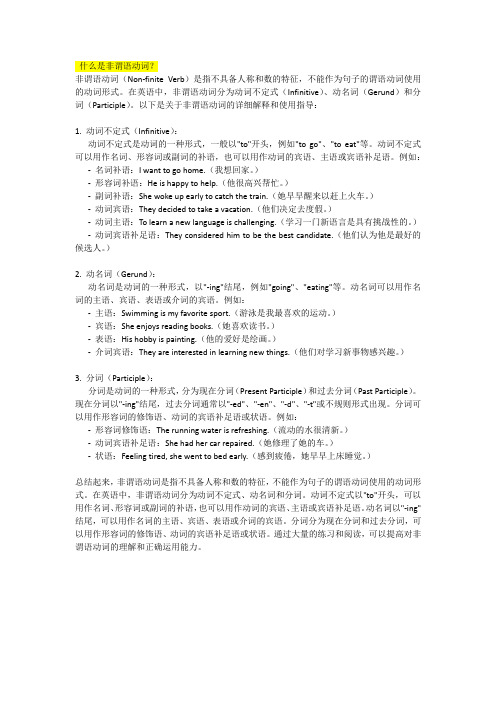
什么是非谓语动词?非谓语动词(Non-finite Verb)是指不具备人称和数的特征,不能作为句子的谓语动词使用的动词形式。
在英语中,非谓语动词分为动词不定式(Infinitive)、动名词(Gerund)和分词(Participle)。
以下是关于非谓语动词的详细解释和使用指导:1. 动词不定式(Infinitive):动词不定式是动词的一种形式,一般以"to"开头,例如"to go"、"to eat"等。
动词不定式可以用作名词、形容词或副词的补语,也可以用作动词的宾语、主语或宾语补足语。
例如:-名词补语:I want to go home.(我想回家。
)-形容词补语:He is happy to help.(他很高兴帮忙。
)-副词补语:She woke up early to catch the train.(她早早醒来以赶上火车。
)-动词宾语:They decided to take a vacation.(他们决定去度假。
)-动词主语:To learn a new language is challenging.(学习一门新语言是具有挑战性的。
)-动词宾语补足语:They considered him to be the best candidate.(他们认为他是最好的候选人。
)2. 动名词(Gerund):动名词是动词的一种形式,以"-ing"结尾,例如"going"、"eating"等。
动名词可以用作名词的主语、宾语、表语或介词的宾语。
例如:-主语:Swimming is my favorite sport.(游泳是我最喜欢的运动。
)-宾语:She enjoys reading books.(她喜欢读书。
)-表语:His hobby is painting.(他的爱好是绘画。
非谓语动词-2023年高考英语必考语法点精讲精练

With so much to exploVr-ee,dC表h宾in语e与se宾a补rc为ha被e动ol关og系is,ts且f表ee动l e作x已ci完te成d.
With the excavation cToomdpol(etteod常, 被Ch省i略ne)se表a动rc作h未ae完ol成ogists feel relieved.
between A and B.
的名词后作定语
Tips:
He is always the first (one) to come and the last (one) to leave.
Part Ⅰ 非谓语动词作定语
▪2. doing(动名词)
a walking stick a swimming pool Tips:常用于表被修饰名词的属性或功
fall in love with someone else. Predicative 表语;O-C宾补 When you feel hurt and your tears are going to drop,
please look up and have a look at the sky once belonging to us… Attribute 定语 He rushed out, shouting “You’re a liar.” Adverbial 状语
were/was done were/was being done had been done
had been being done
现在将来
will be/do
will be done
过去将来 would be/do
would be done
will be doing will be being done
non-finiteverbs概要

非限定动词英语中非限定动词有三种:动词不定式、分词和动名词。
非限定动词在句中能充当谓语的一部分,但不能单独充当谓语,故又称非谓语动词。
它们的形式不随主语的人称和数的变化而变化,但仍具有动词的一般特征,可以带宾语。
一、非谓语动词时态、语态变化形式及其用法当非谓语动词所表示动作发生在谓语动词表示动作之前时,非谓语动词用完成时形式。
例:1)Having finished my homework, I listened to music for relaxation.当非谓语动词所表示动作与谓语动词所表示动作同时发生时,非谓语动词用进行时或一般时形式。
例:2)He pretended to be working hard when his mother entered his room.当非谓语动词所表示动作发生在谓语动词所表示动作之后时,非谓语动词用一般时形式。
例:3)I expect you to write to me.二、非限定动词的句法功能比较动词不定式(或不定式短语)具有名词、形容词和副词的性质,在句中能充当主语、表语、宾语、定语、补语或状语。
动名词(或动名词短语)具有名词形质,在句中常作主语、表语、宾语或定语。
分词(或分词短语)具有形容词和副词的性质,在句中可作表语、定语、补语或状语。
非限定动词的句法功能列表如下:1.动词不定式(短语)、和动名词(短语)作主语的区别1)当主语和表语都是非限定动词形式时,主语和表语的非限定形式要求一致。
例:①To live is to struggle. [正]②To live is struggling. . [误]③Living is to struggle. . [误]④Living is struggling. . [正]2)当主语为非限定动词,而表语不是的时候,不定式和动名词作主语都可以,意义有区别,但区别很小,可忽略。
区别在于:不定式强调动作性,常表示一次性、短暂的动作;而动名词倾向于名词性,常指多次重复的动作。
高中英语复习Non-finite Verb(-ed-form)课件(共25张PPT)

过去分词作__定__语__ —位置
单个的过去分词作定语位于它所修饰的名
词或代词_前__面____;过去分词短语作定语 位于它所修饰的名词或代词后___面____。
(1)They found a damaged car at the gate of the park. (2)He lives in the house built by his father. (3)Have you read this book written by LuXun?
过去分词作定语 —位置
过去分词修饰something, everything, anything, nothing, somebody, nobody,
those 等不定代词时,要放在这些词的_后__面__。
(1)He is one of those invited. (2)Nothing reported (in the newspaper) interested him. (3)He wanted to interview someone related to the matter.
With water heated, we can see the steam.
With the matter settled, we all went home.
Without the job finished, I wouldn't dare to go home.
have + n.+ 宾语补足语
have sb. do sth. 使某人做某事 I’ll have him do it.
have sth. done 使某事被(他人)做 I have my hair cut every month.
英语流利说level7-u2-p3文本
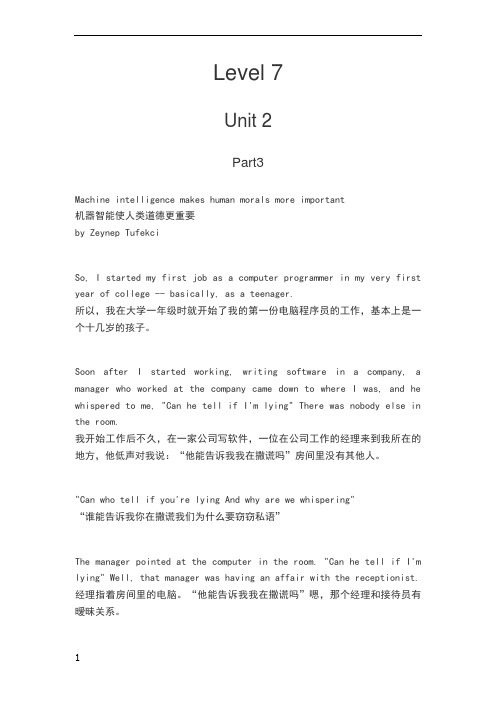
Level 7Unit 2Part3Machine intelligence makes human morals more important机器智能使人类道德更重要by Zeynep TufekciSo, I started my first job as a computer programmer in my very first year of college -- basically, as a teenager.所以,我在大学一年级时就开始了我的第一份电脑程序员的工作,基本上是一个十几岁的孩子。
Soon after I started working, writing software in a company, a manager who worked at the company came down to where I was, and he whispered to me, "Can he tell if I'm lying" There was nobody else in the room.我开始工作后不久,在一家公司写软件,一位在公司工作的经理来到我所在的地方,他低声对我说:“他能告诉我我在撒谎吗”房间里没有其他人。
"Can who tell if you're lying And why are we whispering"“谁能告诉我你在撒谎我们为什么要窃窃私语”The manager pointed at the computer in the room. "Can he tell if I'm lying" Well, that manager was having an affair with the receptionist.经理指着房间里的电脑。
“他能告诉我我在撒谎吗”嗯,那个经理和接待员有暧昧关系。
non-finite

non-finite verbs 和finite verbs.的区别。
A : 概念上的不同根据动词在分句或句⼦中能否单独做谓语可判定non-finite verbs 和finite verbs.1. non-finite verbs 是动词的⾮谓语形式,不能单独做谓语。
1.1. 动名词eg. Seeing is believing.It is no use sading.1.2. 不定式eg. To see is to believe.Nice to meet you.1.3 现在分词eg. Putting my book on the table.1.4 过去分词eg. When we arrived, we were given printed in the strong wind.Excited by the sale figures, we dicided to go out and have a meal.2.finite verbs 在分句或句⼦中做谓语,它受主语的⼈称和时间的限定。
eg: I am a student. She often writes.You are a student.She is a student.B. non-finite verbs and finite verds 并不是两种不同的动词,⽽是同⼀动词的两种的不同形式。
每⼀个动词都有它⾃⼰的限定形式和⾮限定形式。
eg. I am a student. am是系动词,在句中做谓语。
I am studing grammer. am 是助动词,帮助构成进⾏时态。
I have three sisters. have 是实义动词,⽤做谓语。
I have studied English for 13 years. have 是助动词,帮助构成完成时态。
注意:non-finite verbs 虽然不能单独做谓语,但是在做谓语的限定动词短语中,却少不了non-finite verbs.除了现在⼀般时和过去⼀般时以外,其他时态和语态的谓语都是由限定动词短语担任的。
非限定动词基本知识点

非限定动词基本知识点非限定动词(non-finiteverb)一、定义:非限定动词在句中不可单独用作谓语,不受主语的人称和数的限制;它在句中可以用作其他句子成分。
它包括三种:不定式(infinitive)、动名词(gerund)、分词(participles)。
二、功能:主语表语宾语定语状语补语同位语√√√√√√√√√√√√√否定not加在to前面√不定式√动名词√分词三、形式:不定式主动语态一般式todo被动语态tobedone进行式tobedoing完成式tohavedonetohavebeendone动名词主动语态一般式doing被动语态beingdone否定not加在v-ing完成式havingdonehavingbeendone前面☆现在分词的形式等于动名词,过去分词的形式即为动词的过去分词。
☆过去分词通常则表示逻辑主语的动作已完成,或者与逻辑主语间就是被动关系,例如:gonefromhomesolong,theycouldn’trecognizetheplaceatall.(则表示动作已完成)someofthem,bornandbroughtupinvillages,hadneverseenatrain.(则表示被动)四、用法特别注意点:1、不定式①作宾补时,不带to的动词:感觉动词(feel,see,hear,watch,notice等)和使役动词(make,let,have),如:wefeltthehouseshake.iwouldhaveyouknowthatiamill.(不拎to的不定式)☆find与help之后,不定式可以拎to可不拎to。
②“for+名(代)词+不定式”结构,例如:forachildtodothatjobisn’tsuitable.it’stimeforustogo.☆在adj.+forsb.todosth.和adj.+ofsb.tosth.结构中,当形容词表示客观意义时,用for,如difficult,easy,impossible,important,hard等;当形容词表示主观意义时,用of,如nice,kind,good,bad,honest,stupid,silly,clever等。
非谓语动词的7种形式
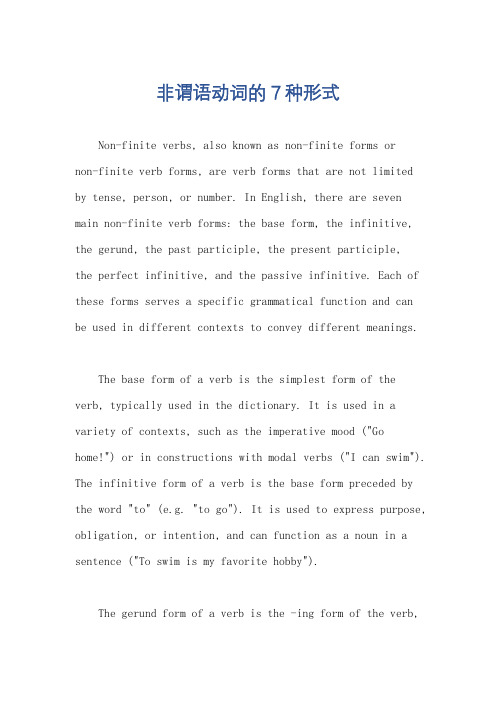
非谓语动词的7种形式Non-finite verbs, also known as non-finite forms ornon-finite verb forms, are verb forms that are not limited by tense, person, or number. In English, there are seven main non-finite verb forms: the base form, the infinitive, the gerund, the past participle, the present participle,the perfect infinitive, and the passive infinitive. Each of these forms serves a specific grammatical function and can be used in different contexts to convey different meanings.The base form of a verb is the simplest form of the verb, typically used in the dictionary. It is used in a variety of contexts, such as the imperative mood ("Gohome!") or in constructions with modal verbs ("I can swim"). The infinitive form of a verb is the base form preceded by the word "to" (e.g. "to go"). It is used to express purpose, obligation, or intention, and can function as a noun in a sentence ("To swim is my favorite hobby").The gerund form of a verb is the -ing form of the verb,used as a noun in a sentence ("Swimming is good exercise"). It can function as the subject or object of a sentence, and is often used after prepositions. The past participle form of a verb is typically used in perfect tenses and passive constructions, as well as in the formation of the passive voice ("The book was written by the author"). The present participle form of a verb is the -ing form, used in progressive tenses and as an adjective ("The running man is my brother").The perfect infinitive form of a verb is the infinitive form preceded by "to have" (e.g. "to have written"). It is used to express completed actions in relation to a specific point in time. The passive infinitive form of a verb is the infinitive form preceded by "to be" (e.g. "to be written"). It is used in passive constructions to indicate that the subject of the sentence is the recipient of the action rather than the doer. Overall, understanding the different forms of non-finite verbs is essential for mastering English grammar and effectively communicating in both spoken and written language.。
新编英语教程7课文翻译_(Unit_1-14_Text_I_译文)

Unit 1 英国人和美国人的空间概念人们说英国人和美国人是被同一种语言分离开的两个伟大的民族。
英美民族之间的差异使得英语本身受到很多指责,然而,这些差异也许不应该过分归咎于语言,而应该更多的归因于其他层面上的交流:从使很多美国人感到做作的英式语音语调到以自我为中心的处理时间、空间和物品的不同方法。
如果说这世上有两种文化间的空间关系学的具体内容迥然不同,那就是在有教养(私立学校)的英国人和中产阶级的美国人之间了。
造成这种巨大差异的一个基本原因是在美国人们借助空间大小来对人或事加以分类,而在英国决定你身分的却是社会等级制度。
在美国,你的住址可以很好的暗示你的身分(这不仅适用于你的家庭住址,也适用于你的商业地址)。
住在纽波特和棕榈滩的人要比布鲁克林和迈阿密的人高贵时髦得多。
格林尼治和科德角与纽华克和迈阿密简直毫无类似之处。
座落在麦迪逊大道和花园大道的公司要比那些座落在第七大道和第八大道的公司更有情调。
街角办公室要比电梯旁或者长廊尽头的办公室更受尊敬。
而英国人是在社会等级制度下出生和成长的。
无论你在哪里看到他,他仍然是贵族,即便是在鱼贩摊位的柜台后面。
除了阶级差异,英国人和我们美国人在如何分配空间上也存在差异。
在美国长大的中产阶级美国人觉得自己有权拥有自己的房间,或者至少房间的一部分。
当我让我的美国研究对象画出自己理想的房间或办公室时,他们毫无例外的只画了自己的空间,而没有画其他人的地方。
当我要求他们画出他们现有的房间或办公室时,他们只画出他们共享房间里自己的那部分,然后在中间画一条分隔线。
无论是男性还是女性研究对象,都把厨房和主卧划归母亲或妻子的名下,而父亲的领地则是书房或休息室,如果有的话;要不然就是工场,地下室,或者有时仅仅是一张工作台或者是车库。
美国女性如果想独处,可以走进卧室、关上门。
关闭的门是“不要打扰”或“我很生气”的标志。
如果一个美国人家里或办公室的房门是开着的,则说明他现在有空。
在这样的暗示下,人们不会认为他想把自己关闭起来,而会认为他正处于一种随时响应他人的准备就绪的状态中。
动词的不定式用法-副本

动词的不定式用法
优秀课件,精彩无限!
1
非谓语动词(non-predicate verb)
概念:在句子中不充当谓语成分,而具有其它功 能的动词。 非谓语动词指的是在句中起名词、形容词和副词 作用的动词形式,而不是作谓语的动词形式。
特点:与谓语动词相比,非谓语动词既不能单独 作谓语,其形式又不受主语的人称或数的限制。 故又称为非限定动词non-finite verb 。
优秀课件,精彩无限! 7
It 做形式主语,to do做真正主语
类似这样不定式做主语的句型有: It is + n.+ to do It takes sb.+ some time + to do It is + adj.+ for sb.+ to do It is + adj.+ of sb.+ to do
优秀课件,精彩无用动词不定式作宾语。这些动词 有want,wish,like,decide,help,pledge(保 证),begin,forget,learn,ask(要求)等等。动词 不定式一般不作介词的宾语。如: He wants to be a village school teacher in a mountain area.他要做个山村教师。 Do you like to watch football matches? 你喜欢看 足球赛吗? Learn to walk before you run.先学走后学跑。 We decided to make changes in our plan.我们决 定把计划做些修改。
优秀课件,精彩无限! 3
Infinitive
非谓语动词(Non-Finite Verb)

非谓语动词(Non-Finite Verb)在英语中,不是用于句子谓语而是用于担任其他语法功能的动词叫做非谓语动词,也称作动词的非限定形式。
非谓语动词有三种形式:不定式(the Infinitive),分词(the Participle)和动名词(the Gerund)。
不定式I.构成与形式不定式由不定式符号“to”+动词原形构成(有时不带to)。
前面可以加某些疑问代词,如what、who、which,或疑问副词,如when、where、how、why 等,构成特殊的不定式短语,如what to do next, how to get there等。
不定式的形式有:II.用法不定式不能单独作谓语,没有人称和数的变化,具有名词、形容词和副词的特征,而且还保留着动词的特征,因而可以有状语修饰,如果是及物动词,还可以带宾语,从而构成不定式短语。
不定式或不定式短语在句中可以作主语、表语、宾语、定语、状语、主语补足语和宾语补足语。
1.作主语To make a plan for our future is important.How to get enough capital is still a question.It is difficult to make a decision without knowing all the facts.2.作表语The important thing is to save lives.What he wanted to do was wash his hands of it.3.作宾语I like to go for a walk in the warm sunshine.We must remember to follow the safety rule.常用不定式作宾语的动词有:agree, want, like, ask, wish, hate, hope, decid e, fail, intend, manage, promise, forget, plan, need, mean, pretend, choose, rem ember, care, continue, require 等。
Non-finite verbs非谓语动词

They prefer spending/to spend their summer vacation in Dalian.
I intend to buy/buying an English-Chinese dictionary.
提 示
应尽量避免接连出现两上 动词-ing形式。 I am starting to learn Russian. 避免说:I am starting learning Russian.
•Painting is his hobby. •Talking mends no holes
2 为了保持句子平衡,通常用先行 词it作形式主语,而把真正的主语 放在句末。
It is no use crying over spilt milk.
作无益的后悔是没有用的。
It's a waste of time arguing about it.
resist抵制
escape 避免
mention 提及 enjoy 喜欢
mind介意
finish 完成
risk 冒险
give up 放弃
include 包括
suggest 建议
forgive 原谅
miss 逃过
imagine 设想 cannot help 情不自禁
② 既可用动词-ing形式作宾语,也 可用不定式作宾语 这类动词虽然既能用-ing形式作 宾语,也能用不定式作宾语,但用 法并不相同,主要有以下几种情况: ☆有些动词,如attempt,continue, hate,intend,like,love,prefer等, 后面接动词-ing形式或不定式区别 不是很大。
go on to do做完一件事后, 接下 去做另外一件事
非谓语动词(Non-finite Verb)
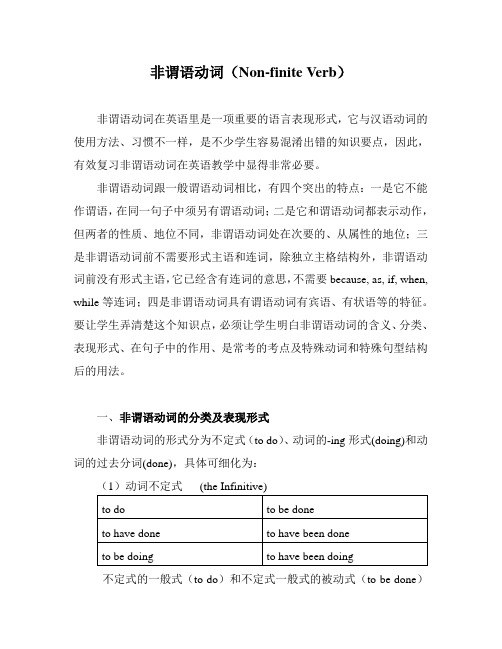
非谓语动词(Non-finite Verb)非谓语动词在英语里是一项重要的语言表现形式,它与汉语动词的使用方法、习惯不一样,是不少学生容易混淆出错的知识要点,因此,有效复习非谓语动词在英语教学中显得非常必要。
非谓语动词跟一般谓语动词相比,有四个突出的特点:一是它不能作谓语,在同一句子中须另有谓语动词;二是它和谓语动词都表示动作,但两者的性质、地位不同,非谓语动词处在次要的、从属性的地位;三是非谓语动词前不需要形式主语和连词,除独立主格结构外,非谓语动词前没有形式主语,它已经含有连词的意思,不需要because, as, if, when, while等连词;四是非谓语动词具有谓语动词有宾语、有状语等的特征。
要让学生弄清楚这个知识点,必须让学生明白非谓语动词的含义、分类、表现形式、在句子中的作用、是常考的考点及特殊动词和特殊句型结构后的用法。
一、非谓语动词的分类及表现形式非谓语动词的形式分为不定式(to do)、动词的-ing形式(doing)和动词的过去分词(done),具体可细化为:(1)动词不定式(the Infinitive)不定式的一般式(to do)和不定式一般式的被动式(to be done)在句中常常表示将来情况,不定式的完成式(to have done)和不定式的完成被动式(to have been done)表示完成状态,不定式的进行式和不定式的完成进行式(to have been doing)常表示动作的进行。
(2)V-ing(动名词the Gerund +现在分词the Present Participle)在句中动词-ing形式的一般式(doing)和一般式的被动式(being done)表示动作正在进行,动词-ing形式的完成式(having done)和完成被动式(having been done)表示动作的完成,且在句中不能作定语,常作状语使用。
(3)动词的过去分词(the Past Participle)在句中动词的过去分词(done)表示被动的、完成的动作。
非谓语动词

动名词的时态和语态
动名词
主动态
被动态
一般式
doing
being done
完成式
having done having been done
成形式。
He is proud of having been sent to work in Tibet . 4.当一个动名词逻辑上的主语是该动名词动作的承
受者, 这个动名词要用被动形式。
He remembered being taken to Beijing when he was a child.
2. 强调不定式的动作在谓语动词之前发生时, 用完成形式。 He is said to have written a novel.
3. 强调不定式的动作正在进行时, 用不定式的进行形式。 When I came in, he pretended to be reading a book.
4. 当不定式的逻辑主语是不定式动作的承受者时, 用被动语 态。
2.动名词(The Gerund),由动词+ing构成。
3.分词(The Participle)
1)现在分词(The Present Participle),由动 词+ing构成
2)过去分词(The Past Participle),由动词 +ed构成。
非谓语动词具有以下特征:
• 非谓语动词可以做主语、宾语等多种句子成分, 但唯独不能做谓语。
1.对称原则:主语和表语对称 Seeing is believing. To see is to believe.
英语语法非谓语动词

The usage of particles
03
The Tense and Voice of Non fine Verbs
English grammar non finite verbs
目录
contents
The definition and types of non fine verbs The use of non fine verbs The Tense and Voice of Non fine Verbs The conversion of non fine verbs and clauses Special usage and precautions of non fine verbs
Article to article
Conversion of particles and clauses
05
Special usage and precautions of non fine verbs
VS
Infinite without "to" is often used as predicate, expressing the subject's ability, opposition, or description For example: "She sings beautifully."
Article
To define: The particle is a verb form that is used adaptively to describe a noun or pronoon It can be either present particle (ending in "- ing") or past particle (ending in "- ed" or "- en") (e.g., "running man," "eating fruit")
专业英语语法:Non-Finite_verb
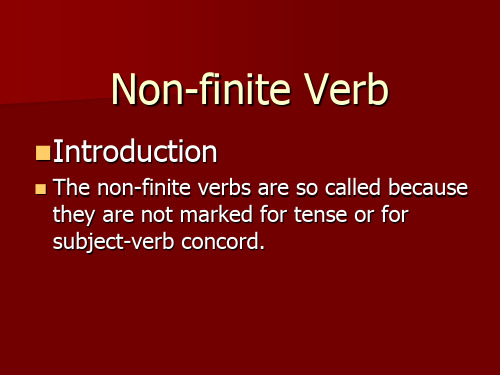
Introduction
The non-finite verbs are so called because they are not marked for tense or for subject-verb concord.
ቤተ መጻሕፍቲ ባይዱ
three types of non-finite verbs:
It's for sb.和 It's of sb. 1) for sb. 常用于表示事物的特征特点,表 示客观形式的形容词,如easy, hard, difficult, interesting, impossible等: It's very hard for him to study two languages.
2) voices
He is said to stay abroad. He is sure to have been taught by a good
musician.
Note: active voice and passive voice.
这个不定式该用主动式还是被动式
--- “Do you have anything ______, Professor Smith?” ---“No, thanks.” A. to type B. typing C. to be typed D. being typed
A. to take
B. to be taken
3)Are you going to Beijing? Do you have anything ____to your son?
A. to take
B. to be taken
4) He wrote a lot of novels, none of them _________ into a foreign language.
grammar(Non-finite verb forms and tense)
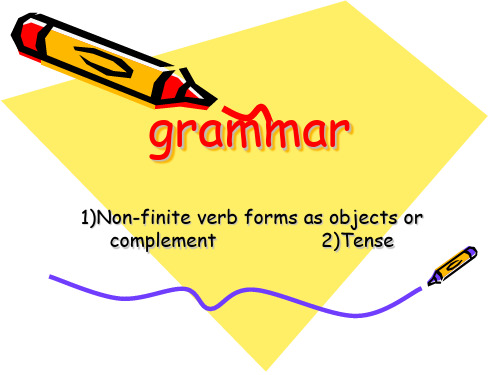
be sworn in
1. The new president will be sworn in January. 新总统将在一月份宣誓就职。
2. Let the witness be sworn in. 让证人宣誓作证。
grammar
1)Non-finite verb forms as objects or compledo… 表示动作完整性 Feel …doing… 表示动作的连贯性,进行性 I saw him work in the garden yesterday. (强调“我看见了”这一事实)
2、“未完成”用法
过去完成体的“未完成”用法表示一个动作或状态在过 去某时之前已经开始,一直延续到这一过去时间,而 且到那时还未结束,仍有继续下去的可能性。 By six o’clock they had worked twelve hours. In 1960, I’d known him for ten years.
关于to做介词
•
介词to,其后就应该跟名词、 代词,如果其后为动词,则应该 采用-ing分词形式。熟悉一些常 见的含介词to的搭配可以帮助我 们区分这两者。
Mary took to being out frequently in the evening. She confesed to having a dread of spiders. Lying on bed, unable to sleep, i got to thinking how nice it would be to go away and start a new life somewhere else.
c) Eg. Your plan would mean spending hours.(意味着) I didn’t mean to make you angry.(打算) If you want to improve the taste, try adding some sugar.(试着) She tried to answer each question by herself. (努力) I regret telling(后悔) / to tell(遗憾) you that john stole it.
- 1、下载文档前请自行甄别文档内容的完整性,平台不提供额外的编辑、内容补充、找答案等附加服务。
- 2、"仅部分预览"的文档,不可在线预览部分如存在完整性等问题,可反馈申请退款(可完整预览的文档不适用该条件!)。
- 3、如文档侵犯您的权益,请联系客服反馈,我们会尽快为您处理(人工客服工作时间:9:00-18:30)。
3. 4.
5. 6.
分词短语
翻译:
用铅笔写的信 被偶然发现的物质
与名词、形容词或副词连用做定语
home-grown
vegetables the above-mentioned point a tree-lined road
As adverbial
可以改为从句看其功能:
Transsentences
Opening the cupboard, a skeleton fell out. Since leaving her, life has seemed pointless. Having worked hard since 6 A.M., the work has completed before noon. Having moved all the things into the garage, there was no room left for the car.
单个分词: 前置定语强调形容词意义
1.
及物动词的过去分词,具有被动和完成意义。
a wounded soldier a broken cup
2.
不及物动词的过去分词,具有主动和完成意义。
a departed friend an expired passport an escaped prisoner
-ed vs. -ing
1. 2.
担任句子成分不同 -ing 含主动进行意义或动名词的功能,而-ed含 被动意义。
1. 2.
Freezing weather vs. frozen food Developing country vs. developed country
悬垂结构
Compare:
2.
评注性状语 p169
To tell you the truth… roughly speaking
3.
当非限定动词暗含的逻辑主语为表示泛指的one或you 时。
When dinning in the restaurant, a jacket and a tie are required. In doing such work, patience is needed. To borrow books from the library, a library card is necessary.
When is the dangling element ok?
1.
独立结构:有主语,但独立主格的主语和句子主语不 一致。
Weather permitting, I will go fishing with my family. The war was over, without a shot being fired.
into English, the sentence was found to have an entirely different word order. Caught in the rain, he had a fever. Considered from this point, the question will be of great importance. Defeated, he remained a popular boxer. The new textbook, as compared with the old one, has many advantages. Peter went to work, burdened with worries.
Example sentences:
She
is a trained therapist. 句子成分 The man killed in the accident is his father.
单个的过去分词做定语:
前置定语 后置定语
过去分词短语做定语:
通常后置 作用相当于定语从句
Sitting
word. Opening the cupboard, a skeleton fell out.
at the back as we were, we couldn’t hear a
如果分词的逻辑主语与主句的主语不一致,该 分词被称为悬垂分词(dangling participle )或无 依附分词(unattached participle) 需避免使用!!!
NON-FINITE VERB 非限定性动词
7.4 –ed 分词
III. –ed分词
Function:
Subject
complement Object complement Attributive Adverbial
As subject complete…
Example sentences:
The
mystery remains unsolved. _________ ______ _______(句子成分)
As object complement
Example sentences:
I
hope I have made myself understood. 句子成分
As attributive
3.
语音变化:
An aged couple His beloved wife A blessed event A learned man
单个分词: 后置定语强调动词意义
1. 2.
the department concerned a concerned look the sum added the added value the question involved the involved questions
